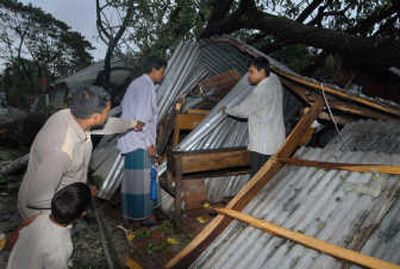Powerful cyclone strikes Bangladesh

KHULNA, Bangladesh – A cyclone packing 150 mph winds slammed Bangladesh’s southeast coast late Thursday, killing at least 41 people and forcing hundreds of thousands from their homes, officials said.
Cyclone Sidr leveled numerous homes as it sent driving rains and high waves across the lowland coastal areas before weakening to a tropical storm today, according to the Bangladesh Meteorological Department.
Government officials across the region said that at least 41 people had been killed, mainly from collapsing homes and falling debris, and 650,000 people had been evacuated.
Storm surges nearly 4 feet high inundated low-lying areas and some offshore islands in the 15 coastal districts in the cyclone’s path. Communications with remote forest areas and offshore islands were temporarily lost.
Torrential rain late Thursday and early today flooded some streets in the capital, Dhaka, while strong winds sent billboards flying through the air.
In the coastal districts of Barguna, Bagerhat, Barisal and Bhola, residents said the storm flattened thousands of flimsy straw and mud huts, flooded low-lying areas, destroyed crops and fish farms, and uprooted trees and electricity and telephone poles. Road, rail and river transport also suffered.
Bangladesh, a low-lying delta nation, is prone to seasonal cyclones and floods that cause huge losses of life and property. The coastal area borders eastern India and is famous for the mangrove forests of the Sundarbans, a world heritage site that is home to rare Royal Bengal tigers.
Thousands of coastal villagers moved to cyclone shelters – concrete buildings on raised pilings – or sought refuge inside “mud forts” – mud walls built along the coast to resist tidal surges. Schools, mosques and other public buildings were also turned into makeshift shelters.